.](https://samnabi.com/media/pages/blog/biking-through-colombia/america-by-train-new-orleans-by-night-and-a-rest-in-mexico/8ed6ce972a-1717967464/amtrak-observation-1000x.jpg)
Our slow travel by rail took us from Canada to Mexico.
Photo by AJ LEON.
America by train, New Orleans by night, and a rest in Mexico
29 March 2016
Kitchener, Ontario, Canada
There are four and a half hours until our train leaves. Julia is rushing to complete some paperwork for her financial return to Elections Canada. She's in the living room, papers strewn across the work table. It seems inevitable to be rushing around at the last minute, whether we're about to take the bus uptown or head off on this adventure thousands of kilometres away. We won't sleep in this bed for another two and a half months.
The preparation for this trip has been mentally exhausting. I've been forced to extract myself from freelance contracts. I've put my projects on ice and prepared for no communication until June. One invoice has been overdue for months, and a few days ago I put that client's website in hibernation mode. As it happens, he sent me payment and requested the final deliverables today. As in, right now. Four and a half hours before our train departs. Part of me wants to pull out my laptop and code away for an hour just to get this project completed. But no — I've set my email auto-responder. I've put all my websites on standby. I'm on vacation.
Of course I'm too plugged in. Of course I'm always on. I reply to emails while sitting on the toilet, because shitting in peace is too unproductive. My mind is in overdrive, and it's high time for some rehab.
Despite our best-laid plans, we're starting out with a lot of uncertainty. Uncertainty about timing, uncertainty about cost, uncertainty about safety...
Julia's paperwork takes longer and longer to finish, and my response is to passively-aggressively keep packing our stuff into the storage locker. I do not want to be caught an hour before the train leaves with a bedroom full of random things to pack. I do not want to spend the next three months flying by the seat of our pants. I'm restless and eager to get going.
Julia's parents arrive at our place for one final cup of tea. We walk nine blocks together to the Kitchener train station, arriving a comfortable fifteen minutes early. Now all there is to do is wait, craning our necks to catch a glimpse of the Sarnia-bound train arriving. Julia's parents send us off with an icon of Saint Panteleimon, the Russian Orthodox patron saint of good health. Julia's father tells us, "Once you have your health, you have everything else."
The train whisks us across Southwestern Ontario. These early hours of our adventure are fun and full of new energy, even though we're cooped up in a tin car looking at the same landscape we've grown up with our entire life. The sun sets as we roll past Waterloo Region's farm country, with its neat little patches of brown, scrubby field yet to be seeded. The coffee is good, the atmosphere is friendly, and the newly-renovated VIA Rail car makes us feel comfortable. Everything is working to affirm our slow-travel idealism.
30 March 2016
Port Huron, Michigan -- Chicago, Illinois
We're resigned to the fact that there is only one way to cross the border at Sarnia without a car — an expensive taxi ride. Aside from the cost (a cool $91), the trip across the border is as pleasant as we could have expected. In the wee hours of the morning, we fix ourselves a hearty home-cooked breakfast in Gordon and Judy's kitchen. I'm glad we were able to catch a few hours of sleep here last night.
A flash of light through the living room window tells us it's time to leave. The chatty driver is in his sixties, and he keeps up a rolling stream of commentary over the 5 AM stillness.
We're miffed to hear that it used to be possible to cross the border by train — but now (since 9/11, he says), the Amtrak and VIA Rail cars stay parked in their respective country's rail yard, achingly close, as freight continues to roll through the border tunnel. I wonder how much of North America's lacklustre progress on intercity transportation can be traced to fears over terrorism.
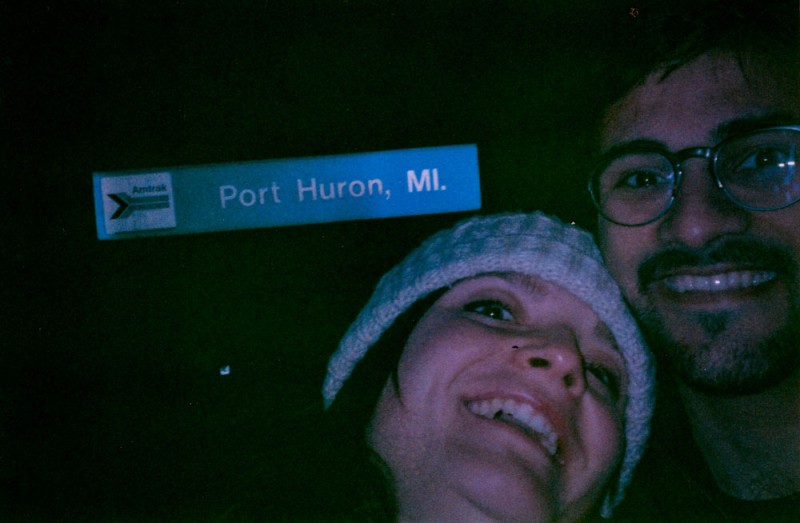
By 6 AM, the tiny Port Huron station is filling up with sleepy-eyed passengers. It seems we're somewhere on the edge of town, in an industrial park not far from the highway off-ramp. The station is all cinder block, Helvetica, and geometric forms. Behind the counter and in the sign out front, they still proudly display the old Amtrak logo, which was formally retired in the year 2000.
This is nostalgic pride — not the rosy memories of better days, but the forthright ambition of an earlier era, reaching forward to lift our chin and tell us to stand straight. It's the pride of a generation that's out of touch with the present. A generation that doesn't realise we've failed to keep up with that ambitious spirit. The station smells like gasoline.
We lost one of our own.
A passenger stepped off the train in Battle Creek to have a smoke, and didn't get back on in time. We left without her. She appears to have been travelling with a group of people, and thankfully they'll make sure to take care of her stuff. They're all very chill about the ordeal — phone calls have been made. Someone will pick her up and they'll all reunite in Chicago. I would like to travel with these people.
The rural Michigan landscape is very much like home. It's more swampy, with more ranch houses and trailer homes. More roadside pancake houses. But there's the same late-winter/early-spring farm fields, the same sparse thickets of trees. The American landscape is a slow gradation.
We are greeted this morning with a fiery, shimmering sunrise like a ball of molten glass. It seems the most magical sunrises and sunsets happen while on vacation. Perhaps that's because you're generally more mindful of your environment. When travelling, your heightened senses of observation help you appreciate new surroundings, not to mention keeping an eye on your bags, counting change, mentally translating and converting foreign measurements. All these minutiae that make travel different and special.
I still have the twitch. That reflexive urge to flip out my phone and check for notifications, reply to email, keep up with Twitter, and feel connected to the world. But we're stepping back from all that. All there is to do here is daydream, look out the window, read, write, and of course eat. My need for distraction could entice me to drop $5 at hourly intervals in the food car, but our trip demands more patience than that. I can handle it. We're sipping the rest of our water, judiciously portioning out our stock of rosehip candies, saving ourselves. Chicago is waiting for us in the morning, and it has deep-dish pizza.
The other thing to do, of course, is to eavesdrop. The group that lost one of their members in Battle Creek has been casually chatting this whole time. It's coming to light that they are a group of chefs. I'm fascinated by their talk of ego in the industry, or the intricacies of hot sauce. They have strong and differing opinions about Sriracha.
31 March 2016
Chicago, Illinois -- New Orleans, Louisiana
We're somewhere south of Memphis, and the sun has just risen. Well, almost — let's say the low, heavy cloud cover is brightening from inky black to a dull purple-grey. It'll stay that way for the rest of the morning.
We trundle past endless swaths of newly-seeded fields, their green shoots bright and uniform in the flat earth. An odd one out flashes by, the brown soil just raked in perfect rows one foot apart. Perhaps the seeds have just been planted. Is this rice? The ground is awfully wet. Some stretches look like a vast, broad river. This landscape is deceiving.
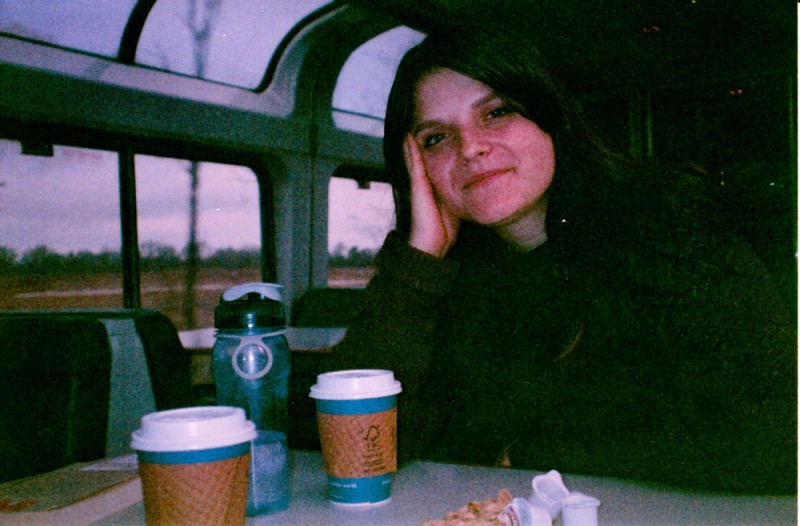
We're on the second-storey observation deck of the City of New Orleans. That's the name of our train. The curved glass roof and big picture windows make me feel like a real old-timey traveller. Julia and I snack on pistachios and contemplate our surroundings. "Is rice a grain? Is it like wheat? Or is it a grass?" There is no wifi here, so we remain blissfully ignorant.
The double-decker train bobs left and right like an inverted pendulum. It's hard to find our footing as we walk down the aisle to get food or go to the bathroom. I feel like I'm getting accustomed to life on the train, even contorting myself in the tiny lavatory to wash my hair and shave. But the side-to-side lurching still throws me off guard.
The sun has finally broken through the clouds, and we are enjoying a wonderful golden light here in the observation car. We're now approaching Greenwood, Mississippi, and the land is still very wet and flooded. Fields morph into swampy forests, which blend into a flowing river and it's hard to tell if there's any dry land at all. The earth is red, like Prince Edward Island. The small country roads running parallel to the train track look as if they're made of pottery. Terra-cotta hues tinge everything.
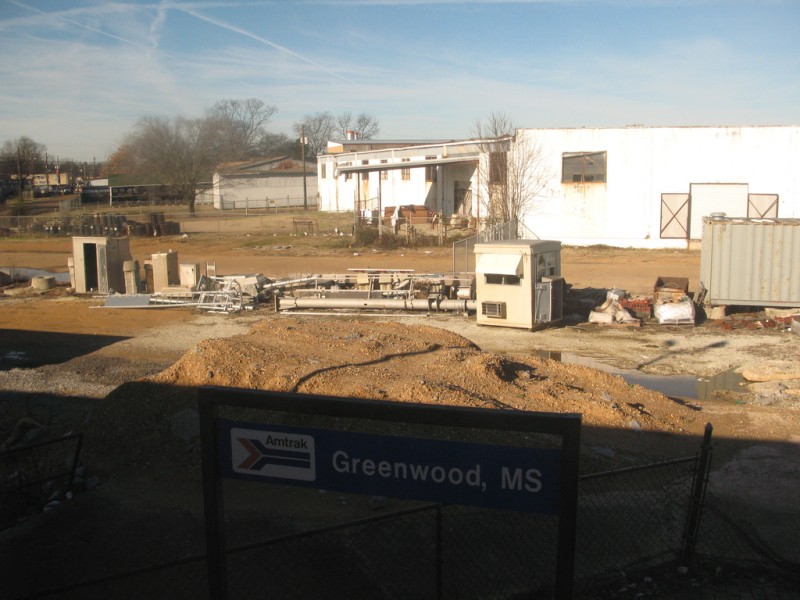
Greenwood, from the view of the train, seems ramshackle. All old wood siding and corrugated aluminum. Like other towns we've passed through, trailer homes abound. I can see why, in this context of middle America, the car is held up as an icon of personal freedom. It's the freedom to move beyond these towns of rusted-out water towers and Main Streets that are but a shell of their former glory.
We pull out of the station, headed further south, and there's an entire neighbourhood submerged in water. The flooding around here, the drenched fields, the red-tinged roads... this must not be normal. It must have been unexpected. Peoples' cars, backyard furniture, all under water. Whole blocks are covered with several feet of water... but the houses look so normal, so lived-in... except for the fact that they have water lapping at their porches. I wonder if they build basements in Mississippi.
Hours pass. Are we somehow in the Mississippi Delta? Is this train, with its hundreds of passengers and crew and freight and luggage, carving a path through the final surge of North America's longest river? The Mississippi, having collected all the volume of rivers and creeks and farm runoff as far north as the Canadian border, is now bursting forth in a final exhale to meet the sea. In much the same way that a sprinter lunges forward and splays her arms as she approaches the finish line, the river's arms, tightly coiled until now, are spreading out, reaching, stretching, giving way to a frenzy of outward energy.
And are we, humble travellers, able to sit atop a berm or across a bridge, neatly cleaving two straight rails through the vast, wet muck of the delta?
1 April 2016
Bourbon Street, New Orleans
I've never seen a den of vice as unabashed and boisterous as Bourbon Street, New Orleans.
We arrived in New Orleans, and walked twenty blocks north of Loyola Street to our hostel. After sitting on the train for so long, we welcomed the opportunity to stretch our legs. We're staying in Mid-City. A passer-by informs us that she recently moved to Mid-City and the thing she most dislikes isn't the "crackheads" or "homeless people" (her words), but the giant caterpillars that leave welts the size of dinner plates.
But back to the den of vice. I can see why the French Quarter is such an attractive tourist destination — the legacy of Spanish and French colonisation has imbued this neighbourhood with a distinct European feel. All wrought-iron balconies, narrow streets, and intricately-carved stone.
But this is America. So all that history is, of course, overlaid with neon signs and a celebration of binge drinking. Nestled between the Hand Grenade ("Bourbon's strongest drink!"), Hustler's "barely legal" nightclub, and kitschy voodoo souvenir shops, there's just enough New Orleans culture to lend legitimacy to this street, to differentiate it from a casino or a giant frat party.
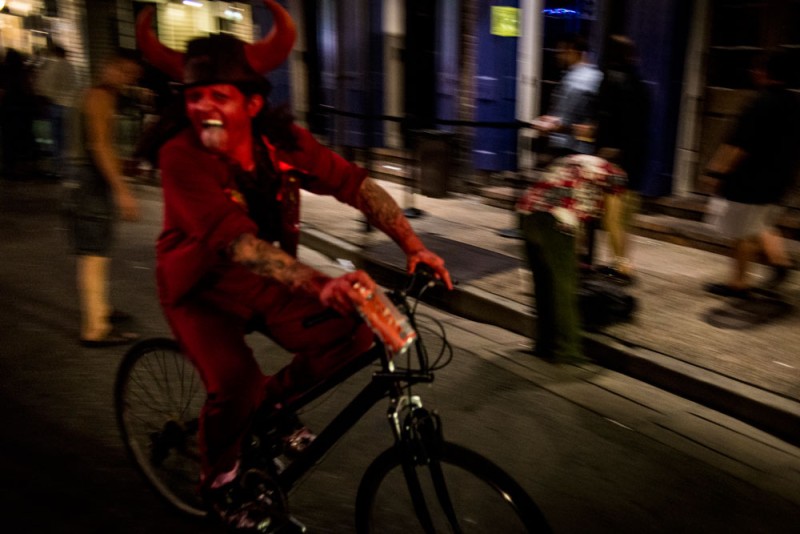
The neon signs compete in an arms race for attention and money — "64 oz fish bowl", "huge ass beers", "3 for 1", et cetera. But there's another dimension to the entertainment, one that needs a bit of cognitive dissonance — or a few more beers — to gloss over. There are lots of street performers, jazz musicians plying their trade for tips. This is normal. We peel off a couple dollar bills for a ten-piece brass band that is improvising and entertaining and generally having a good time. Half a block along Bourbon, we come across one of the many young black boys tap-dancing on the sidewalk, an empty liquor box placed in front for tips. He's performing, working same as the brass band, but there's a twist of history that makes me cringe. The scene of a negro boy dancing for entertainment is a little too close to the line between past and present. His box is much more empty than the brass band's.
As the night goes on, I understand that homelessness and panhandling are also part of the entertainment. Two women sit on a street corner with a rainbow-coloured sign declaring, "LESBIANS need CASH 4 STRAP-ON!" There's a crust punk couple slouched against a lamppost with their dog, furtively counting change. The cardboard-scrawled message at their feet says, "Give a fuck, spare a buck."
In the face of this oversaturation of visible homelessness, my typical coping mechanism is to slowly ignore it, or to reflect upon the misfortune from a distance. But the carnival atmosphere of Bourbon Street makes it seem that the performers, pandhandlers, and drag queens on display outside sex clubs are all part of the same sordid show.
2 April 2016
Jefferson Davis Parkway, New Orleans
There are neighbourhoods in some American cities where you just don't go. Where danger lurks around every corner. Where one wrong move, one misstep, could easily be the difference between life and death.
Everyone needs to watch their back in these neighbourhoods. The streets here are unfriendly at best, and at their worst, they actively try to kill you. But you won't hear about these places in a travel guide warning or a list of crime hotspots. These pockets of death and hostility fly under the radar, under our noses, even.
If you pay attention, you can identify their characteristics: wide, fast-moving lanes of traffic. Overgrown, narrow, or non-existent sidewalks. Unmarked pedestrian crossings. Blind corners. Wide, sweeping curb radii. On-ramps. Industrial loading docks. Sky-high billboards advertising personal injury lawyers.
Avoid these areas at all costs — especially if you are new to town. Make one false move, and you could easily be a deer in the headlights.
This has been a reflection on our morning run around New Orleans' Jefferson Davis Parkway and its adjoining industrial area.
Lower Ninth Ward, New Orleans
We visit the lower ninth ward in the afternoon. The internet told us there are good po-boys to be had here, and it was right. Creamy, crispy, fattening and fresh all at the same time, we scarf down shrimp (me) and fish (Julia) po-boy sandwiches under the awning of Cajun Joe's. It's a busy corner restaurant — takeout only — beside an overgrown, vacant, fenced-in lot. Across the street, a taco truck competes for business.
The lower ninth has hollowed out since Katrina, for sure, but it's pleasant enough to walk around. No worse off than the tracts of foreclosed homes we saw in South Chicago or the outskirts of Detroit, or our view along the train route through Mississippi — which, granted, is pretty damn miserable. But we certainly don't feel unsafe. We walk along carefree — even when caught in an unexpected downpour.
Around the corner from Cajun Joe's is a museum that we had read about online. "Museum" is a generous label — in reality, it's a converted garden suite in the back of the owner's property. The House of Dance and Feathers is a celebration of Black, Native American, and Creole culture. It's a treasure trove of artifacts, history embodied in real objects. There are precious few plaques or information panels.
Ronald Lewis, the owner and curator of the museum, sits near the entrance on a white plastic lawn chair. He invites us to simply inquire about anything we're interested in. And we do. We have a great time in the cramped little room, re-discovering history from a new angle.
We had wanted to do some volunteering in New Orleans, and Ronald gives us the perfect task: helping prepare the newly-built shed that will become the museum's second room. We spend a couple hours painting and chatting, and by the time we leave, Ronald has gifted us with a signed copy of his book — a definitive cultural education of the lower ninth ward. We also leave with a jester doll, a token of appreciation for our time.
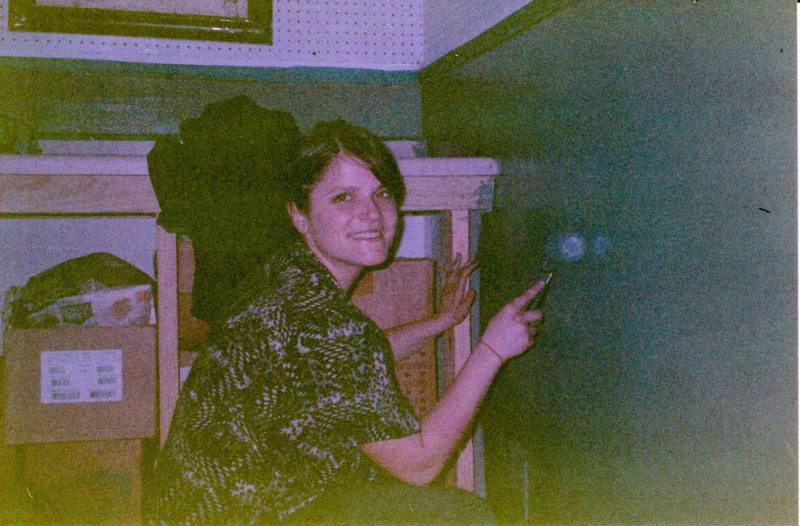
We suffer another miserable torrential downpour on the way back to the hostel, but I have a feeling we'll soon forget that part of the day. The House of Dance and Feathers, that little nugget of cultural preservation, will live on.
Frenchmen Street, New Orleans
At night, we venture to Frenchmen Street, home of the famous blues bars and jazz lounges. It's no less touristy than Bourbon Street, but the inebriated masses here are less boisterous, less crazed. It's a faithful replica of any good European party street, like Rue Mouffetard in Paris or Prague's old city.
We soak in the atmosphere, and dance badly to a tired blues band at a quaint bar called the Apple Barrel. I'm glad to have experienced it. Two drinks and $11 later, we wander back through the shuttered French Quarter, being sure to avoid Bourbon.
Aware of our early train departure in the morning, we start packing as we prepare for bed. Many of our clothes are still wet and it doesn't look like they will dry in time for morning. More distressing is the fact that my phone appears to have suffered from the water damage — the very phone that should be our alarm in the morning. The screen flickers, stubbornly showing a cryptic lightning bolt-and-cog symbol... this is bad news.
With all the enthusiasm of a teenager going to write an exam on a Saturday morning, we pull ourselves up from the bed where we had hoped to rest our heads. Six hours' sleep has turned to five, and we take an emergency trip to Walgreens at 2 AM to buy an alarm clock.
The staff at Walgreens outnumber us two-to-one, and our frantic search for a timepiece provides some welcome entertainment during the graveyard shift. Some of them are adamant that they no longer sell alarm clocks: "Everything is on their phones nowadays," (which, of course, is precisely the problem.)
The magic of global capitalism turns to our favour and the security guard finds a row of clocks for sale on the bottom shelf underneath the batteries. We pay $20 for the assurance of a couple hours' sleep before we have to wake up for the San Antonio-bound train. Looking back, I think it was worth it.
4 April 2016
New Orleans, Louisiana -- San Antonio, Texas
The last two days have been a sleep-deprived wonderful whirlwind of a time. New Orleans seems like a distant memory. The Walgreens alarm clock woke us faithfully on time. We made our way to the train station through New Orleans' crazy streets as if stepping through passed-out bodies and bottles after a house party.
We're happy to be moving on. The westbound Sunset Limited, true to its name, rewards us with a shimmering molten gold-orange sunset over Texas cattle farms. As it dips into the horizon, we settle into as good a sleep as you can get on a moving train. There are a few rowdy drunks on board, but by evening they've settled into playing cards or laying passed out in their seats. There's quite a lot more drinking on this train than there was on the City of New Orleans.
In Houston, we stop to stretch our legs. The conductor informs us that we'll be stationed here for a little over an hour, so Julia and I make a split-second decision to venture into town for a decent vegetarian dinner. Houston is not the most welcoming city — at least, not the part we covered in our 15-minute walk from the train station. Between a high-stress game of real-life frogger across inhospitable roads, a statue of George Bush (Senior, but still), and the ticking deadline of our train's departure, it makes for a nerve-wracking hour.
Miraculously, we make it back to the train in time. Our arms are laden with tacos and salad and chips with guacamole, each dish packed in its own spacious styrofoam container. We feel a little guilty with our take-out picnic in the dining car. A little mutinous, even, against the charming Elwood, our dining car attendant with the Mr. Moviephone voice. But it was delicious.
Before long, San Antonio rolls up and we exit the last train of our southbound trip. It's late evening and our plan is to pull an all-nighter before boarding a Greyhound to the Mexican border at 4 AM. We're ready, if not rested. And San Antonio delivers — we spend 20 minutes and seven dollars in a lively boxing-themed bar where an excellent cover band plays funky eighties hits. The music is better than anything we had heard in New Orleans, and the bar is full of middle-aged married couples dancing together and having a good time. Even though we're smelly and sleepy from travel, San Antonio gives us a warm embrace.
This welcome sets the tone for the next few hours, as we make our way slowly along the Riverwalk. Everyone we see seems to be fat, happy, and calm. Everyone is eager to have fun on this Saturday night, but there's none of the frantic, hedonistic energy of a typical party district. We take in the scene with pleasure, and feel as if just walking through the city is a restful practice in itself.

At the San Antonio Greyhound station, we decide to modify our trip to avoid crossing the Mexican border on foot. We had originally planned on disembarking stateside in Laredo, then trekking with our luggage across the pedestrian bridge to Nuevo Laredo. We had Googled it, people do this all the time. No problem. But now, travel-weary and without our best wits about us, we take the prudent route. We'll stay on the bus all the way to Monterrey, Mexico. This proves to be a wise decision: Laredo before sunrise looks like an mean, unforgiving border town straight out of a Clint Eastwood movie. Better to be whisked along to a more cosmopolitan city in the air-conditioned bus.
Monterrey, Mexico -- Mexico City, Mexico
We emerge from our second straight night of stiff-backed, restless sleep at Greyhound's North Monterrey terminal. We're now in America Latina proper, meaning two things — it's now time to start speaking Spanish in earnest, and everything is cheap as chips.
I start getting flashbacks to former trips abroad — El Salvador, Morocco, Karachi — litter-strewn streets, dusty footpaths, an abundance of taxis, cracked sidewalk tiles, corrugated steel shopfront coverings. It's a delicious feeling of anticipation.
Our first stop at a refresquería features a freshly blended papaya smoothie for twenty pesos. At our second stop, we indulge in hot-as-hell cheese and pepper tacos (thirty pesos). Third stop: a self-serve scale outside of a church, plastered with the image of the saints. I'm curious to see if I've gained any weight during the trip so far. The scale wasn't functional and ate our money. Two pesos.
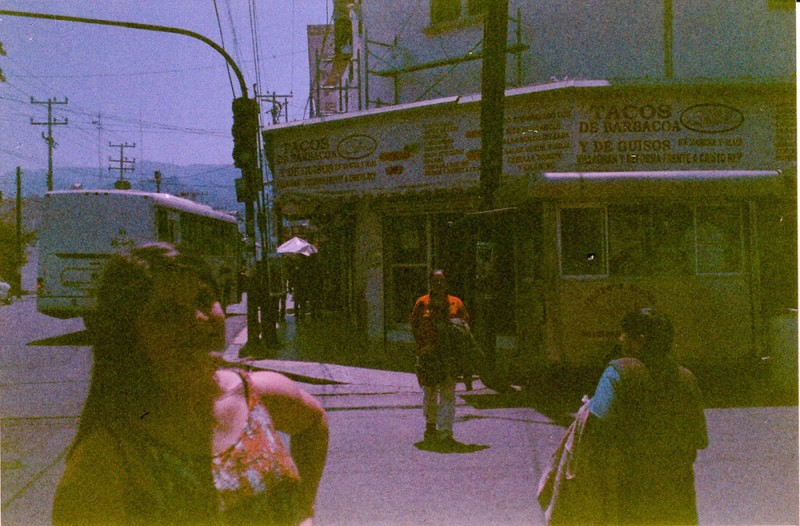
The balls of my feet are starting to hurt from so much walking, although it is pleasant to be moving under our own steam for a change. Here in Monterrey, there's a calm, approachable quality to the streets. Even the dozens of strip clubs and massage parlours seem like quaint family-run businesses. (And they very well might be.)
We finish our Monterrey day trip at a seafood restaurant next to the bus terminal. Julia orders an entire fish: bones, eyes, and all. I indulge in a tostada, empanada, and bottle of Coke. We watch American Top 40 music videos from the blaring CRT television in the corner. The friendly restaurant owner asks if we are married. Outside, street vendors sell candy, illicit DVDs, socks, handbags, sunglasses.
One more marathon bus ride. One more smelly, showerless, bedless night. One more day of wearing the same socks and T-shirt, the T-shirt which a bird had seen fit to shit on this afternoon in a Monterrey park. There's no doubt about our bohemian credentials. All our clothes need a wash. The sun has risen once again over our dirty, sweaty heads. Our hostel room will be ready in two hours and we can't wait to get clean. Julia is hangry.
Welcome to Mexico City.
Sam Nabi